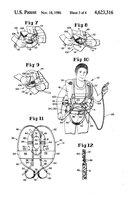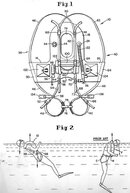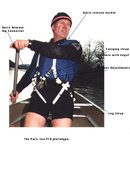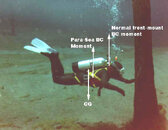Many (professional) golf ball divers don't wear BC's.
A diver might collect 600 -700 balls on a dive .. about 60-70 lbs.
60 lbs of balls is pretty negative and the bag can easily be snagged on something, plus some mud and debris and leaves etc. get into the bag during the ball stuffing process.
All the golf ball divers I have seen, do not wear fins. Instead, they wear heavy boots (over top of normal dive boots), with ankle weights around them and they also wear enough lead on the BC/harness and weight belt(s) to be able to walk/run/crawl on the bottom. This is around 12-15 lbs negative (before the balls) in order to be heavy enough to run over the bottom in a bent over position with their arms outstretched and hands spread over the bottom. If the diver is not at least that negative, then they can not effectively "run" on the bottom.
Often the visibility precludes seeing the spg, but generally there is time to move up slope to make an exit. It is not a big deal to run 20 ft up slope, stick your head out of the water, see where you are relative to the golf shot and check the air pressure. Generally balls will accumulate along the banks and generally concentrate at the bottom of slopes, where the edge meets the flat bottom. So that is where the search effort is concentrated. Even with bad visibility, the experienced golfball diver can detect this sloping feature and knows which way to turn in order to run up slope and make an exit. Often this edge is close maybe, 10-30 feet from the edge of the pond surface. Obviously this is a gross generalization and some lakes have vertical walls of rock which were cut mechanically when the lake was excavated during the construction of the golf course.
However, sometimes it is worthwhile to work "the middles" which is much more difficult and dangerous. The diver may not be able to read the pressure gauge, may not be able to read a compass (doubtful they have one actually) and there are zero topographic features to provide reference. In addition, it is extremely hard to run a straight course while running blindly over a flat muck bottom and there is very little ability to judge depth changes with any accuracy. The inability to run a straight course is also hindered by the drag and weight of hundreds of balls in a big mesh bag that is clipped off on one side of the diver, always pulling and dragging them to the side.
So.. if a diver were to get lost in the middle it is a challenge. They might have to resort to hand swimming and BC filling to fight like heck to make it to the surface in a negative condition, spin around, see which way shore is and then rapidly and uncontrollable sink back to the bottom (remember wearing ankle weights and snow boots) and try to "remember" which way shore was and then try (once again) to run the proper direction (blindly) to reach the shore before the air runs out.
If a problem develops, it might be essential to be able to ditch the large bag of balls. If the bag is attached with a barrel clip or something, it is not unusual for it to be jammed with sand and debris since it is constantly being drug on the bottom. If it is attached to the harness rather than a weight belt (which should have a quick release buckle), it could go downhill fast.
It is not a trivial endeavor and is done solo.
It is not unusual for construction debris and other dangerous materials to have been disposed of in these ponds. There are lots of things that can go wrong and the divers do not carry a secondary independent air source and I have never seen an octopus being used either, it would be filled with mud and debris anyway after half an hour.
It's not a good recreational activity, even though it superficially sounds like it is shallow, simple and easy. I'm not sure if I understand if he was trespassing (and doing it for fun) or was working as a "professional"?







